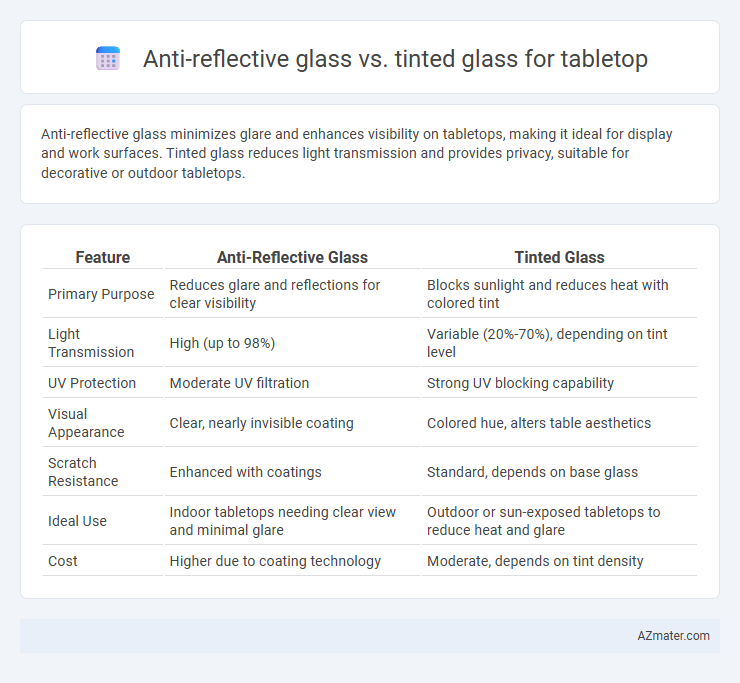Anti-reflective glass minimizes glare and enhances visibility on tabletops, making it ideal for display and work surfaces. Tinted glass reduces light transmission and provides privacy, suitable for decorative or outdoor tabletops.
Table of Comparison
| Feature | Anti-Reflective Glass | Tinted Glass |
|---|---|---|
| Primary Purpose | Reduces glare and reflections for clear visibility | Blocks sunlight and reduces heat with colored tint |
| Light Transmission | High (up to 98%) | Variable (20%-70%), depending on tint level |
| UV Protection | Moderate UV filtration | Strong UV blocking capability |
| Visual Appearance | Clear, nearly invisible coating | Colored hue, alters table aesthetics |
| Scratch Resistance | Enhanced with coatings | Standard, depends on base glass |
| Ideal Use | Indoor tabletops needing clear view and minimal glare | Outdoor or sun-exposed tabletops to reduce heat and glare |
| Cost | Higher due to coating technology | Moderate, depends on tint density |
Introduction to Anti-Reflective vs Tinted Glass
Anti-reflective glass is engineered with special coatings that minimize glare and reflections, enhancing visibility and clarity for tabletop surfaces. Tinted glass incorporates color pigments that reduce light transmission and provide privacy while adding aesthetic appeal and UV protection. Choosing between anti-reflective and tinted glass depends on the desired balance of light control, transparency, and design style for tabletop applications.
How Anti-Reflective Glass Works
Anti-reflective glass works by using multiple layers of dielectric coatings that reduce the amount of reflected light on the surface, allowing more light to pass through and enhancing visibility and clarity. This technology minimizes glare and reflections, which is especially beneficial for tabletops where clear, unobstructed views are essential. In contrast, tinted glass primarily reduces glare by absorbing light but can darken the appearance and reduce transparency.
The Science Behind Tinted Glass
Tinted glass for tabletops functions by incorporating metal oxides during manufacturing to absorb specific wavelengths of light, reducing glare and heat transmission. This absorption process minimizes visible light and infrared rays, thereby enhancing comfort and protecting tabletop surfaces from UV damage. Unlike anti-reflective glass, which uses coatings to reduce surface reflections, tinted glass achieves its effect through material composition, offering a durable solution for controlling light and temperature.
Visual Clarity and Light Transmission
Anti-reflective glass offers superior visual clarity by minimizing glare and reflections, which enhances the viewing experience on tabletops, especially under bright lighting conditions. It allows high light transmission, typically over 90%, preserving natural colors and details without darkening the surface. Tinted glass reduces light transmission to around 40-70%, which can create a stylish appearance but may diminish visibility and alter the true colors of objects placed beneath the tabletop.
Aesthetic Differences for Tabletops
Anti-reflective glass offers a clear, pristine surface that enhances visibility and highlights the natural beauty of tabletop materials without glare or distortion. Tinted glass introduces color and subtle shading, creating a unique aesthetic that can complement modern or artistic decor by adding depth and mood. The choice between them depends on whether clarity and purity or tinted ambiance and style are preferred for the tabletop's visual appeal.
Durability and Maintenance
Anti-reflective glass for tabletops offers superior durability due to its scratch-resistant coatings and reduced glare, requiring minimal maintenance to keep its clarity intact. Tinted glass, while also durable, may show fingerprints and smudges more prominently, necessitating frequent cleaning to maintain its aesthetic appeal. Both materials are robust, but anti-reflective glass provides easier upkeep and longer-lasting pristine appearance in high-use environments.
Impact on Room Ambience
Anti-reflective glass enhances room ambience by minimizing glare and reflections, resulting in clearer visibility and a more open, airy atmosphere ideal for modern interiors. Tinted glass influences ambience by filtering natural light, creating a warmer, moodier environment while reducing heat and UV exposure, suitable for cozy or intimate settings. The choice between anti-reflective and tinted glass for tabletops directly affects light quality and room perception, shaping the overall aesthetic and comfort of living spaces.
Cost Comparison
Anti-reflective glass for tabletops generally costs more due to specialized coatings that reduce glare and enhance clarity, often priced 20-40% higher than standard glass. Tinted glass is more affordable, offering basic light filtration and UV protection with manufacturing costs closer to regular glass, making it a budget-friendly option. Choosing between the two depends on whether the priority is visual performance or cost efficiency, with anti-reflective glass favored for premium setups despite its higher price.
Best Use Cases for Each Type
Anti-reflective glass is ideal for tabletops in environments with strong lighting or visual displays, minimizing glare and enhancing clarity for tasks like reading or intricate work. Tinted glass offers superior UV protection and reduces heat, making it perfect for outdoor tabletops or sun-exposed areas where both style and functional shading are desired. Choosing between these types depends on the primary need for visual comfort or environmental control in the tabletop setting.
Making the Right Choice for Your Tabletop
Anti-reflective glass reduces glare and enhances clarity, making it ideal for tabletops in brightly lit environments or homes with significant natural light. Tinted glass offers UV protection and reduces heat transfer, adding privacy and comfort, especially in sunny spaces. Choosing the right glass depends on your priorities between visibility, protection from sunlight, and aesthetic preferences for your tabletop.

Infographic: Anti-reflective glass vs Tinted glass for Tabletop
 azmater.com
azmater.com